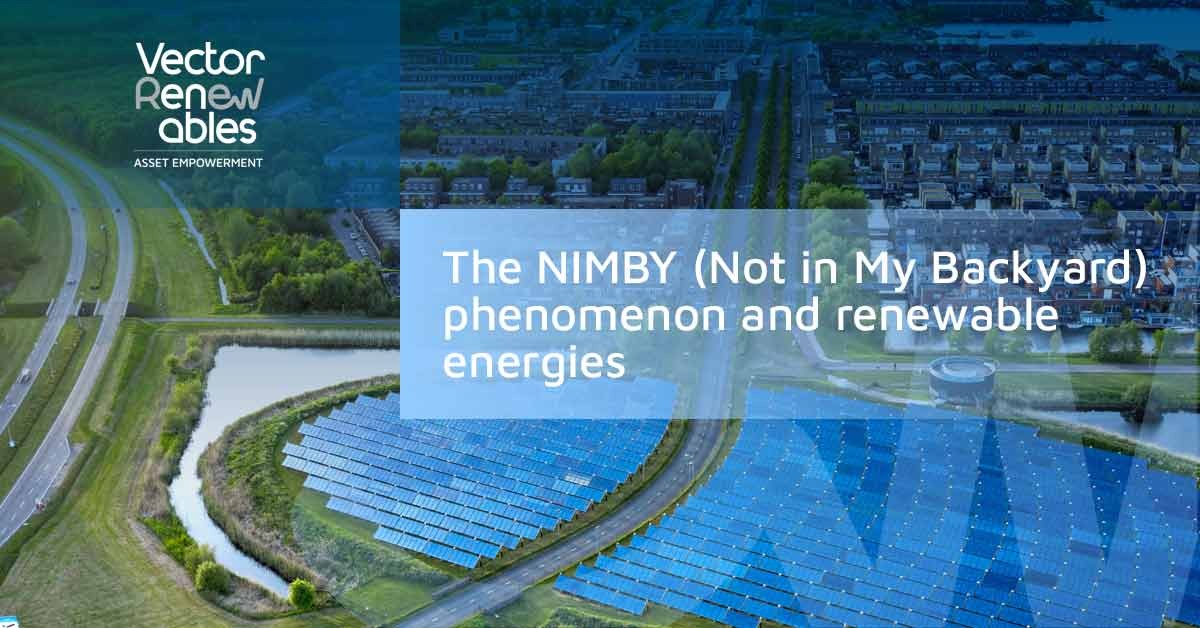The NIMBY (Not in My Backyard) phenomenon and renewable energies
The energy transition is impossible without renewable energy and, despite public agreement, not everyone wants a solar plant or a wind farm as a new neighbor.
NIMBY (Not in My Backyard), or community opposition to proposed renewable projects in their local area, is a common phenomenon that raises many questions we will try to answer in this post.
What is the NIMBY phenomenon?
NIMBY is an acronym for "Not in My Backyard”. It consists of a social community's direct opposition to the negative effects of a new project on its local area.
It is not a phenomenon that is exclusive to the installation of renewable energy parks, however. NIMBY can also be related to the installation of telephone antennas, airports, nuclear power plants and landfills.
The irony of NIMBY groups in terms of renewables (and any other project) is that they want to enjoy their benefits, as long as it isn’t in their immediate surroundings.
Where did NIMBY start?
NIMBY was first mentioned in a U.S. newspaper in 1980. It was used to refer to opponents of a nuclear waste site. Since then, the term has been used whenever a social group comes out in opposition to projects that it thinks will be negative to its local area.
As renewable energy becomes more established and new farms are in the works, NIMBY is becoming a more frequent phenomenon. The Not in My Backyard phenomenon is happening in all markets, so being ready to handle it is crucial.
What consequences does NIMBY have on renewables?
Specifically, the reasons most often cited by NIMBY groups are changes to the landscape and damage to the natural environment, which we will explain in more detail below. In Ireland and the United Kingdom, where the main technology is wind power, renewable energy developers are repeatedly confronted by NIMBY communities, who are unable to see the benefits of these facilities.
According to a study by MDPI (Multidisciplinary Digital Publishing Institute) on 'Renewable Energy Acceptance Trends in Europe', acceptance of projects, particularly in Spain, is likely related to economic impact, participation in the granting of permits and having absolute transparency in communication, among other things.
This prevents urgent and necessary measures from being taken towards today's much-needed zero-carbon efforts. All the organizations involved in the sector (both the UN and the vast majority of governments and environmental organizations) agree that we need to accelerate the energy transition to slow down the rise in global temperatures.
Currently, the impact of renewables on wildlife and plants is dramatically reduced thanks to regulatory developments and the important role that ESG (Environmental, Social, and Governance) policies play during the entire life cycle of a project. This means that only those projects will be built that have the required environmental permits, offer the greatest socioeconomic benefits and are better integrated into their surroundings.
And the benefits of renewables that NIMBY groups might ignore?
• Reduced electricity rates. The greater the number of renewable energy facilities, the more competitive the energy prices.
• More infrastructure for the local area, something that attracts new people to the region and keeps others from migrating.
• Compatibility with agriculture and livestock farming. We’ve already established that we don't have to choose between agriculture and renewables; both successfully coexist in agrivoltaics. Plus, renewables are more than just an opportunity for unproductive land, and solar parks where livestock are allowed to enter the enclosure to graze freely are an increasingly common sight.
• No impact on air quality. Unlike fossil fuel plants, renewables do not pollute the environment, so residents can enjoy high air quality.
• Lower global CO2 emissions. Each new wind or solar farm is another step towards achieving zero carbon and a more sustainable planet. Plus, these two technologies use very little water, so their water footprint is extremely low.
• Creation of direct jobs. The project involves construction workers, designers, installers, etc. According to a study by the International Renewable Energy Agency (IRENA), the renewable energy sector could reach 38.2 million jobs by 2030.
How can you manage the NIMBY phenomenon?
This is undoubtedly one of the major challenges that the renewable industry is facing today. Although there is no clear answer, there are certain actions that can be implemented, including:
1. Transparent communication with the local community prior to project implementation. Communicating the reasons for the choice of location, the benefits for the environment (closely related to the ESG approach) and the plans to prevent environmental impact on the area is crucial.
2. Schedule a series of meetings and discussions to hear all opinions.
3. Avoid trying to impose the project, which will only provoke more resistance from NIMBY groups.
4. Monitor local and online information about the project to help fake news from being spread.
We are dealing with a complex phenomenon that requires discussion and communication. Do you think that we will be able to achieve energy decarbonization in time, despite the NIMBY phenomenon? Let us know what you think.
When you subscribe to the blog, we will send you an e-mail when there are new updates on the site so you wouldn't miss them.

